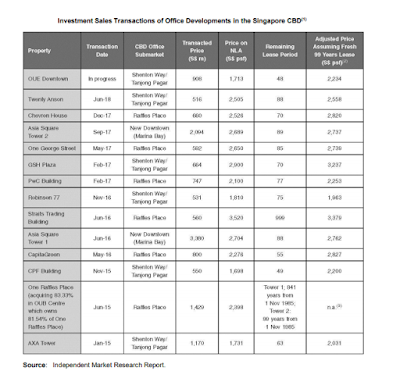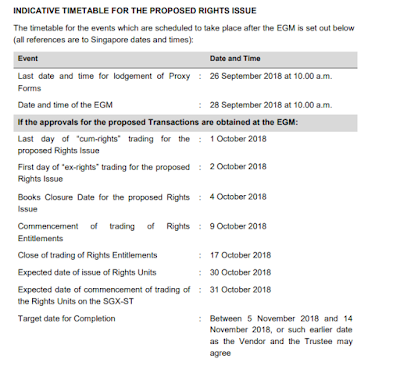It’s been quite a while since we last had an M&A news that involves right issuance hence I think it is time to refresh our memory on how we can play this for interested parties.
The proposed acquisition this time is from their own sponsor, OUE Limited, with the acquisition of the OUE Downtown, which comprises of both 50-storey building Downtown 1 and 37-storey building Downtown 2, as well as some retail podium and carpark which they had not too long ago carried out an enhancement work.
The proposed acquisition is in the range of $908m, which is a slight discount from the independent valuer perspective, and together with some transaction and admin fee, it will total up to around $956m.
The funding will be made partly via borrowings of $361.6m while the rest of the $588m will be funded via equity rights issuance.
Is This A Good Acquisition?
The sponsor is well known to recycle their properties to the Reits in order to free up cashflow for other purposes.
It happens with the Crowne Plaza Changi Airport for OUEHT a few years ago, and then One Raffles Place and now this.
In this case, OUE Downtown is divested at $1,713psf with around 48 years of lease period remaining.
This compares in line with the recent divestment of CPF Building which was divested at $1,698psf with around 49 years of lease period remaining back in late 2015.
You can see from the table below that most buildings with longer lease command a much higher price above $2,500psf, so this theory syncs well with the lower revaluation as the lease gets shorter.
The acquisition also comes with a few years of rental support and this has been a very common financial engineering platform used by most sponsors in order to get rid “recycle” their properties fast.
Do also note that Lippo Plaza has also 26 years of lease period remaining, so all this so called “NAV” needs to take into account the difference in properties such as OUE Downtown and Lippo Plaza, and properties with longer lease such as OUE Bayfront and One Raffles Place.
In my opinion, this is not a good acquisition considering all factors but one which we all know they are going to come anyway (that’s the main reason the sponsor list the Reit platform in the first place).

Rights Issuance
The manager proposes to issue 1,288,438,981 Rights Units to raise a gross proceeds of $588m on a pro rata basis of 83 Rights Units for every 100 units held at an issue price of $0.456 per Rights Units, which is a huge 31.4% discount to the last closing price of $0.665 as at 10 Sep 2018.
The issuance is renounceable which technically in layman terms it means it can be traded in the market. If you don’t like the deal, you can sell off your rights entitlement but risk getting diluted if you are still holding the mother share.
The theoretical ex-rights price (TERP) in this case is $0.57 per unit.
The 3 Levels
I am going to repeat the 3 levels that folks have to watch out for the benefits of those who are reading my blog for the first time.
This will impact you as unitholders or someone who are looking to take advantage into this situation.
First Level – The general occurrence is that when a Reit announces their plans on a placement or rights issuance, the market will view that as negative and hence the share price would usually fall. At this point, usually the details of the offering is not out yet to the public but there are sufficient indication to suggest otherwise.
Second Level – The second level is when the devil details are out. This is especially so when the issuance are done at a huge discount and the acquisition does not result in obvious yield accretive nature. You can see how the market reacts with the share down by 3.5% today once the news are out. The market will continue to adjust until the market deemed the suitable TERP price.
Third Level – The third level is usually reserved for renounceable rights where the rights are transferable and can be traded in the market. The rights are being traded in the market for people who wants to dispose their entitled rights or who wants to get into the company by buying the rights from the market.

The 3 Groups of People
In this environment, you then belong to these few types of people.
First Group – People who are currently holding the existing mother shares:
If you are holding the mother shares, you can choose whether you want to continue holding until it goes ex-rights on the 2nd October or sell them in the open market like you usually did with your other position.
If you are choosing to hold until it goes ex-rights, you’d be entitled for 83 rights units for every 100 shares, then you have two further options.
The first option is to sell the rights when it commences trading in the market on the 9th October but keep the mother shares. Do note that doing this will give you dilution right away and your pro-forma yield will go down to almost 6.2% should you participate not to exercise the rights.
The second option is to exercise the rights during the exercise period and apply for excess rights as much as possible as this will favour those who wants to get more at a much discounted price.
Hint: If you are willing to go until this point, then you might as well whack and apply as much excess rights as you can as there are good chances that you can get a good amount of excess that other people are selling off.
Second Group – People who are not holding the mother shares but want to get some actions
There are a few options that you can take as well.
The first is buying the mother share before it goes ex-rights on the 2nd October and thus you will be entitled to the rights. You can then follow the first option above.
The second is simply buying the mother shares right after the whole episode is done and dusted.
This should set the tone how “low” the shares will go down in this particular exercise.
For a strong Reit, this usually does not work well as the share price would rebound back quickly but for this Reit I think the chances are good.
Third, you can dip toe into the market by buying the rights in the market which would allow you the rights to exercise the mother share at the rights price.
Third Group – People who wants to participate but don’t have enough funds to subscribe
You’d be surprised to learn that there are many people who doesn’t have sufficient funds when their respective Reits call for an equity fundraising activity.
Not to worry, if you are in this state, then you can either sell the rights in the market by choosing not to participate or you can use the method of “swallowing the tail”, a term used by philosopher in the past where you can see part of your current holdings, get some funds and then use them to subscribe to the rights offerings.
Final Thoughts
It’s still early days so there are plenty of time for you to think about how you can participate in this.
If you are lucky enough, there can be arbitrage opportunities in rights exercise or even if not, sometimes a very good opportunity might surface.
With the market going southwards and there are other better opportunities in the market, I will be foregoing on this one unless it becomes compelling to purchase by continuing its fall downwards.
Thanks for reading.
If you like our articles, you may follow our Facebook Page here.


Hi B, like to ask why do you think this is not a good acquisition? Thanks!
Hi Yeo
For one, the acquisition is dilutive to the dpu, which post acquisition and rights your dpu of 3.54 cents is equivalent to 6.2% at the original terp price.
The market deemed it too low yield which is the reason why the mother share price is going to have a free fall all the way from now until the rights starts trading on the market on the 2nd oct then have another free fall thereafter.
At today closing price, the revised terp price is now at 55 cents which makes post acquisition yield around 6.4%. Still not good enough in my opinion and the market mechanism will continue to correct until the yield becomes 7% in my opinion for a fair value which means there could still potentiall be around 20% fall from here.
The acquisition of the assets also has around 47 lease years remaining and the whole deal is just for the sponsor to dump and recycle their funds elsewhere.
This is a good example of value destroyer for shareholders.
Hi B, can you name some example of 'good' acquisitions of property from sponsor company by other REITs? Thanks!
Hi Anonymous
I wrote a post on it a couple years back which I think is very much still relevant.
http://foreverfinancialfreedom.blogspot.com/2017/05/my-thought-process-when-selecting-reits.html?m=1
In general, Reits that creates value are those that can price its share price above premium to nav then do an equity raising for an npi yield which is easier to be yield accretive. Keep doing and rinsing this is the goal of the management that aligns well with shareholder interest.
Hi,
Would like to hear your thoughts.. if you are holding now to the mother share, what would you do if your cost is 70c per share
1. Sell your rights, and buy back shares ex rights when price has fallen to low
2. Keep rights and buy more…in hope of averaging down and keep earning dividends
Thanks
Hope this reit is not a big portion of your portfolio.
If not. Suggest just hang on and apply for excess rights.
The mother has been quite impatient with capital recycling. Eg. with One Raffles Place. Even when this reit was created it was pieced up with income support for Bayfront.